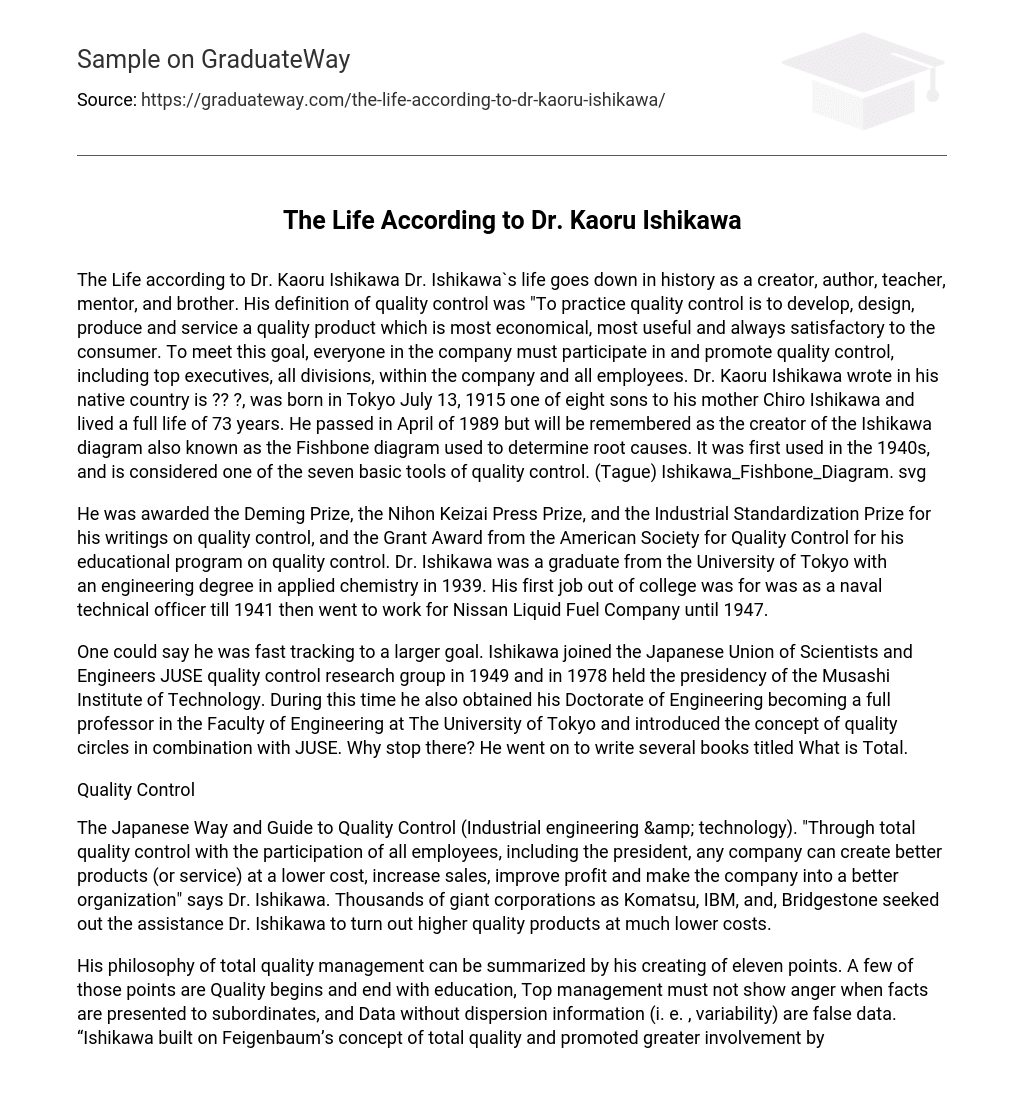The Life according to Dr. Kaoru Ishikawa
Dr. Ishikawa`s life is remembered for his roles as a creator, author, teacher, mentor, and brother.
His definition of quality control was “To practice quality control is to develop, design, produce and service a quality product which is most economical, most useful and always satisfactory to the consumer. To meet this goal, everyone in the company must participate in and promote quality control, including top executives, all divisions within the company and all employees.
Dr. Kaoru Ishikawa was born in Tokyo on July 13th 1915 as one of eight sons to his mother Chiro Ishikawa. He lived a full life of 73 years.
He passed away in April of 1989 but will be remembered as the creator of the Ishikawa diagram also known as the Fishbone diagram used to determine root causes. It was first used in the 1940s and is considered one of the seven basic tools of quality control (Tague). Ishikawa_Fishbone_Diagram.svg
Dr. Ishikawa was honored with accolades including the Deming Prize, the Nihon Keizai Press Prize, and the Industrial Standardization Prize for his significant contributions to quality control. Moreover, he received the Grant Award from the American Society for Quality Control in recognition of his educational program on quality control. After graduating from the University of Tokyo in 1939 with a degree in applied chemistry, Dr. Ishikawa served as a naval technical officer until 1941 and subsequently joined Nissan Liquid Fuel Company where he worked until 1947.
One might say that Ishikawa was quickly advancing towards a bigger objective. He became a member of the Japanese Union of Scientists and Engineers JUSE quality control research group in 1949. In 1978, he achieved the presidency of the Musashi Institute of Technology. Simultaneously, he obtained his Doctorate of Engineering and became a full professor in the Faculty of Engineering at The University of Tokyo. Furthermore, he introduced the concept of quality circles in conjunction with JUSE. But Ishikawa didn’t halt at that point; he also authored multiple books titled “What is Total.”
Quality Control
The Japanese Way and Guide to Quality Control (Industrial engineering & technology). According to Dr. Ishikawa, through total quality control involving all employees, including the president, any company can enhance its products/services, reduce costs, boost sales, increase profit, and transform into a better organization. Big corporations like Komatsu, IBM, and Bridgestone have sought Dr. Ishikawa’s help to produce superior quality products at significantly reduced expenses.
His philosophy of total quality management can be summarized by his creation of eleven points. Some of these points include the idea that quality begins and ends with education, top management should not display anger when presented with facts by subordinates, and data without dispersion information (i.e., variability) is considered false data. “Ishikawa expanded on Feigenbaum’s total quality concept by advocating for increased participation from all employees, from top management to frontline staff, and reducing reliance on quality professionals and departments” (Evans).
It is the responsibility of all individuals within the company to ensure that the products produced are of high quality. According to Neuhauser, improving people’s quality of life directly contributes to better service outcomes and productivity.
Dr. Kaoru Ishikawa, a visionary, aimed to reform internal and external operations of companies. He emphasized that the well-being of individuals associated with the company should be the primary concern in management.
If a company cannot prioritize the happiness of people or fails to make them happy, it should not be permitted to exist. It would be optimal if all companies adhered to this principle.
References
- D, Neuhauser . Kaoru Ishikawa from fishbones to world peace: Qual Saf Health Care 2008;17:150-152, Retrieved November 12, 2011
- Evans, E. , Lindsay, W. (2008). Managing for Quality and Performance Excellence. Mason, Ohio. (pg 112) Tague, Nancy (2004).
- “Seven Basic Quality Tools”. The Quality Toolbox. Milwaukee, Wisconsin: American Society for Quality. p. 15. Retrieved November 10, 2011.





